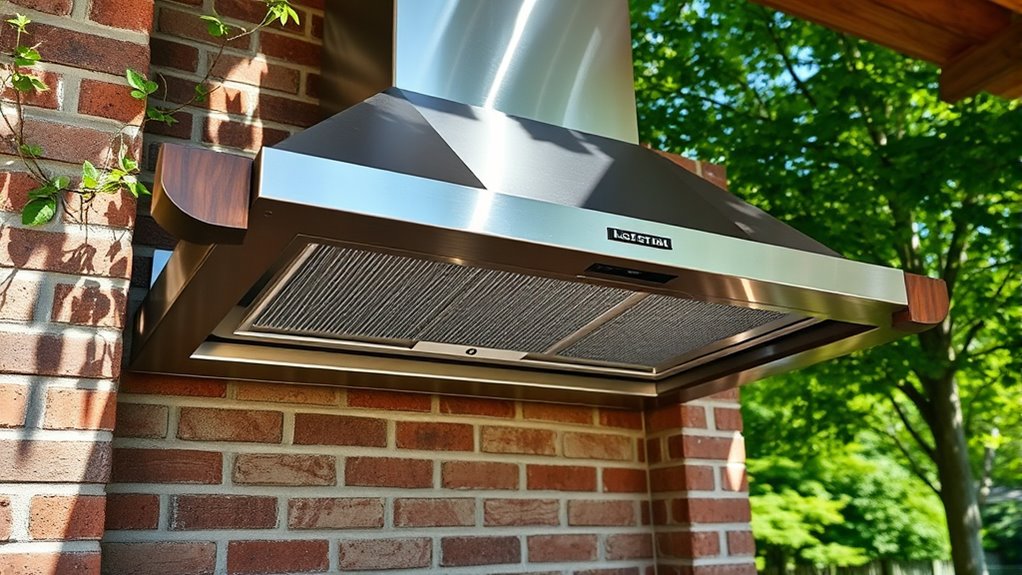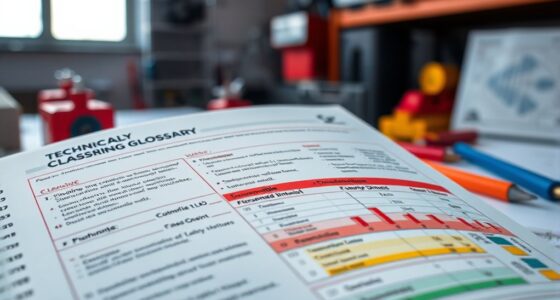To avoid hidden costs with outdoor vent hoods, you must plan for weatherproofing, proper ventilation, and durable materials. Don’t overlook local codes and permits, which can cause delays and fines if ignored. Skimping on quality components or neglecting routine maintenance leads to early repairs and system failure. Also, consider future upgrades and professional installation costs. Staying ahead with these essentials helps prevent surprises—if you continue, you’ll discover how to keep your project smooth and cost-effective.
Key Takeaways
- Invest in high-quality, weatherproof materials and finishes to prevent premature rust, corrosion, and costly replacements.
- Obtain all necessary permits and schedule inspections early to avoid fines, delays, and rework costs.
- Properly route and seal ductwork to ensure optimal airflow, reduce energy costs, and prevent fire hazards.
- Regular maintenance and cleaning extend system lifespan, improve performance, and prevent costly repairs.
- Budget for future upgrades, permits, and unexpected expenses with detailed estimates and professional guidance.
Underestimating Weatherproofing and Durability Needs

Many outdoor vent hoods fail prematurely because their weatherproofing and durability features are underestimated from the start. You might think that basic materials will withstand the elements, but neglecting proper weather resistance shortens your vent hood’s lifespan. Harsh weather, like rain, snow, and UV exposure, can erode materials if they aren’t designed for outdoor use. Choosing durable, weather-resistant materials ensures your vent hood maintains its integrity over time. Material longevity depends on quality and how well the design defends against environmental stressors. Investing in high-quality weatherproofing minimizes corrosion, rust, and degradation. Without it, your vent hood will likely require costly replacements sooner than expected. Prioritizing weather resistance from the beginning saves you money and guarantees reliable performance in all seasons. Proper weatherproofing techniques can significantly extend the lifespan of outdoor vent hoods.
Overlooking Local Building Codes and Permits
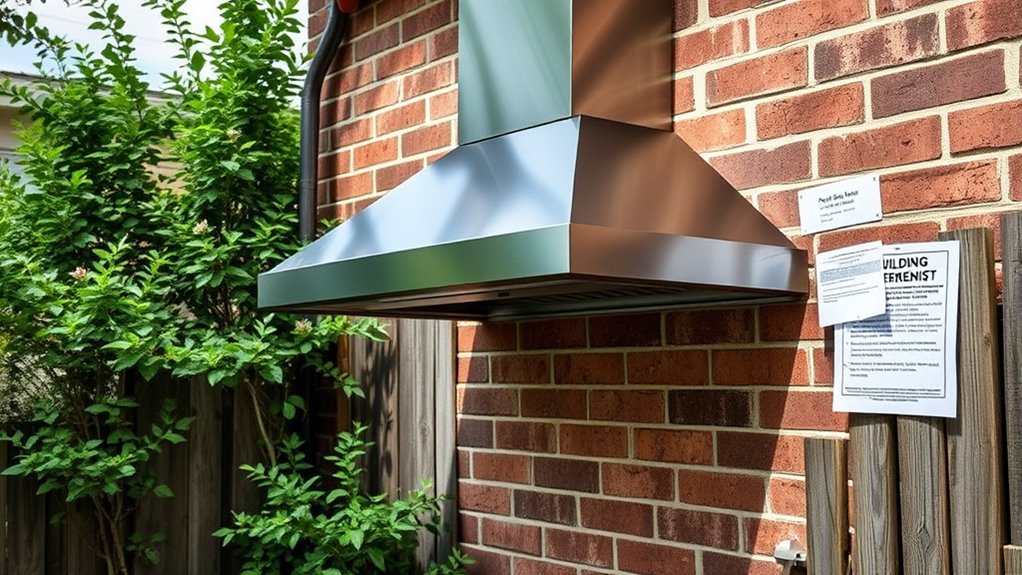
Ignoring local building codes and permit requirements can lead to costly delays and fines. You might face permit approval issues, inspections, or even having to undo work if violations are found. Staying informed helps make certain your outdoor vent hood project proceeds smoothly and legally. Additionally, understanding local security regulations can prevent potential legal complications related to outdoor installations.
Permitting Requirements and Delays
Before starting your vent hood project outdoors, it’s essential to understand that local building codes and permit requirements can critically affect your timeline. The permit process varies by location, and some jurisdictions require approvals before beginning work. Failing to secure the proper permit can lead to delays, fines, or even having to redo the work to meet code standards. Research your area’s building code to determine what permits are necessary for outdoor vent hoods. Starting the permit process early helps avoid surprises later. Keep in mind that processing times can vary, so plan accordingly. Ignoring these requirements might save time initially but can cause costly setbacks once discovered. Staying compliant ensures your project proceeds smoothly and avoids unnecessary delays or penalties. Additionally, understanding local regulations related to outdoor installations can help you anticipate potential compliance issues beforehand.
Code Violations and Fines
Overlooking local building codes and permit requirements can lead to serious consequences for your outdoor vent hood project. Ignoring these rules risks violations that can result in costly fines, delays, or even safety hazards. To avoid this, pay close attention to:
- Ensuring your vent hood meets fire safety standards to prevent hazards.
- Complying with ventilation standards to promote proper airflow and prevent buildup.
- Securing all necessary permits before starting installation to avoid penalties.
- Understanding the importance of adhering to Fokos guidelines to maintain safety and compliance.
Failing to follow these regulations can lead to fines or forced modifications, which increase costs and delay your project. Additionally, non-compliance can compromise fire safety and ventilation efficiency, putting your property and loved ones at risk. Always verify local codes to keep your outdoor vent hood compliant and safe.
Inspection and Approval Process
Guiding the inspection and approval process is essential to guarantee your outdoor vent hood project meets all safety and code requirements. Expect inspection hurdles, which can slow down your project if you overlook local building codes and permits. Failing to prepare properly may lead to approval delays, forcing you to redo work or submit additional documentation. To avoid these issues, research the specific regulations in your area before starting construction. Schedule inspections early and ensure your setup adheres to all safety standards. Keep detailed records of permits and approvals to streamline the process. Being proactive minimizes surprises and helps you navigate the approval process smoothly, saving time and preventing costly setbacks. Staying compliant from the outset ensures your outdoor vent hood project passes inspection without unnecessary delays. Additionally, understanding reviews and ratings can provide insights on quality and performance, helping you select the best options for your project.
Ignoring Proper Ventilation and Exhaust Routing

Ignoring proper ventilation and exhaust routing can lead to serious problems, such as poor airflow, lingering smoke, and the buildup of grease and fumes. Without correct ventilation troubleshooting, your vent hood won’t function efficiently. To avoid these issues, pay attention to:
- Ensuring the exhaust route is direct and unobstructed.
- Properly sealing duct connections to prevent leaks.
- Choosing the right duct material to resist grease buildup and heat.
- Using self-watering plant pots to maintain consistent moisture and prevent overwatering issues that can contribute to mold and moisture-related problems in your kitchen environment.
Neglecting these steps can cause smoke and fumes to recirculate, creating health hazards and increasing cleaning needs. Proper exhaust routing is essential for effective vent hood operation. Always verify your ventilation setup matches manufacturer guidelines and local codes to maintain safety and efficiency. Skipping this can lead to costly repairs and compromised air quality.
Skimping on Quality Materials and Components
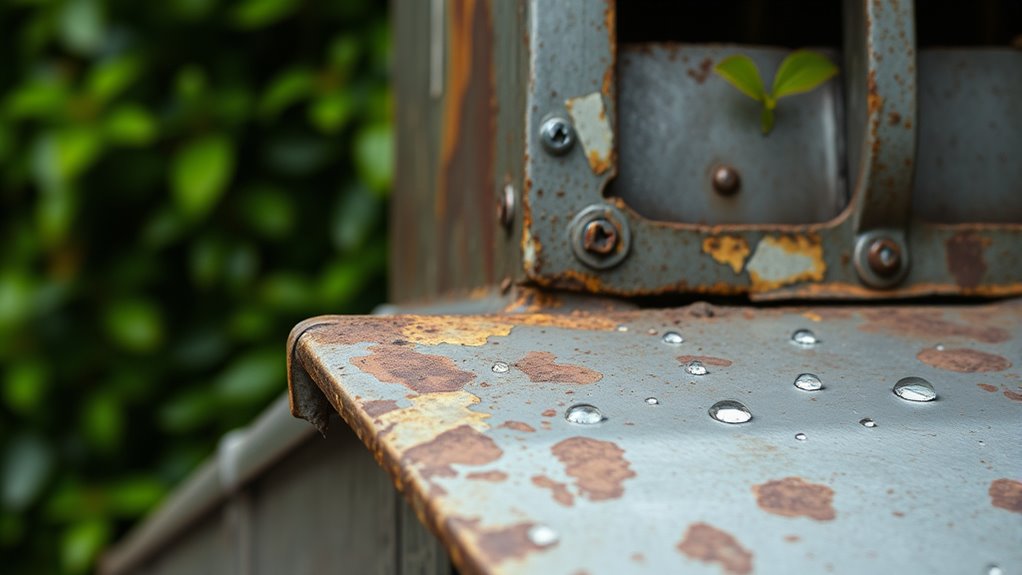
Choosing cheap or low-quality materials and components for your vent hood might save you money upfront, but it can lead to costly problems down the line. Poor material quality can cause rust, warping, or failure under outdoor conditions. Likewise, poor component selection may result in inadequate ventilation, noise issues, or electrical failures. Investing in durable materials and reliable components ensures longevity and peak performance. When selecting materials, consider corrosion-resistant metals and weatherproof finishes. For components, prioritize high-quality fans, filters, and electrical parts. Using trending genres can also help attract more readers and boost sales. Here’s a quick comparison:
| Material Quality | Component Selection | Expected Durability |
|---|---|---|
| Low-grade metals | Generic fans | Short lifespan |
| Rust-prone finishes | Cheap filters | Frequent replacements |
| Weatherproof options | Subpar electricals | Risk of failure |
Skipping quality sacrifices your investment’s value and safety.
Neglecting Routine Maintenance and Cleaning
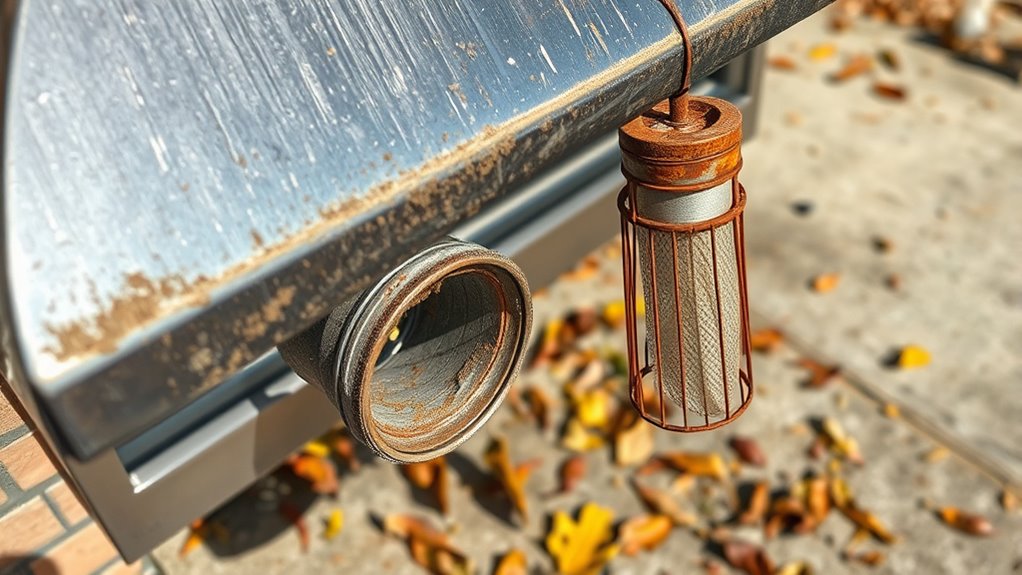
If you neglect routine maintenance and cleaning, dirt can quickly build up in your vent hood. This buildup reduces airflow and makes your system less efficient. Regular cleaning helps prevent these issues and keeps your outdoor vent working smoothly. Incorporating data-driven strategies can help you establish an effective maintenance schedule to avoid costly repairs.
Dirt Buildup Risks
Neglecting routine maintenance and cleaning of your outdoor vent hood can lead to significant dirt buildup, which poses health and safety risks. Over time, grease and debris accumulate, increasing fire hazards and reducing air quality. To prevent these issues, pay attention to:
- Clogged air filter: Dirt and grease can block airflow, forcing your system to work harder and increasing fire risk.
- Dirty grease trap: Failing to clean the trap allows grease to overflow, creating fire hazards and foul odors.
- Build-up on surfaces: Dust, grease, and debris can settle on the hood and vents, reducing efficiency and promoting mold growth.
- Inadequate color accuracy can lead to misdiagnosis of issues with your ventilation system, making maintenance more difficult.
Regularly inspecting and cleaning these components keeps your outdoor vent hood safe, efficient, and free from dangerous dirt buildup.
Reduced Vent Efficiency
When routine maintenance and cleaning are ignored, your outdoor vent hood’s efficiency drops markedly. Dirt and debris clog the filters and fan components, disrupting airflow enhancement. This reduces the fan’s ability to effectively remove smoke, odors, and excess heat. Poor fan placement can exacerbate the problem, causing the vent to work harder and consume more energy. Over time, this strain leads to decreased performance and increased wear on the motor. Neglecting regular cleaning also allows grease buildup, which hampers airflow and can pose fire hazards. To maintain peak efficiency, clean filters and inspect the fan regularly. Adjust fan placement if necessary to ensure unobstructed airflow. Proper upkeep keeps your vent hood working at peak performance and prevents hidden costs down the line. Additionally, ensuring the system uses efficient heating solutions can help reduce energy consumption and prolong equipment lifespan.
Underestimating the Cost of Professional Installation
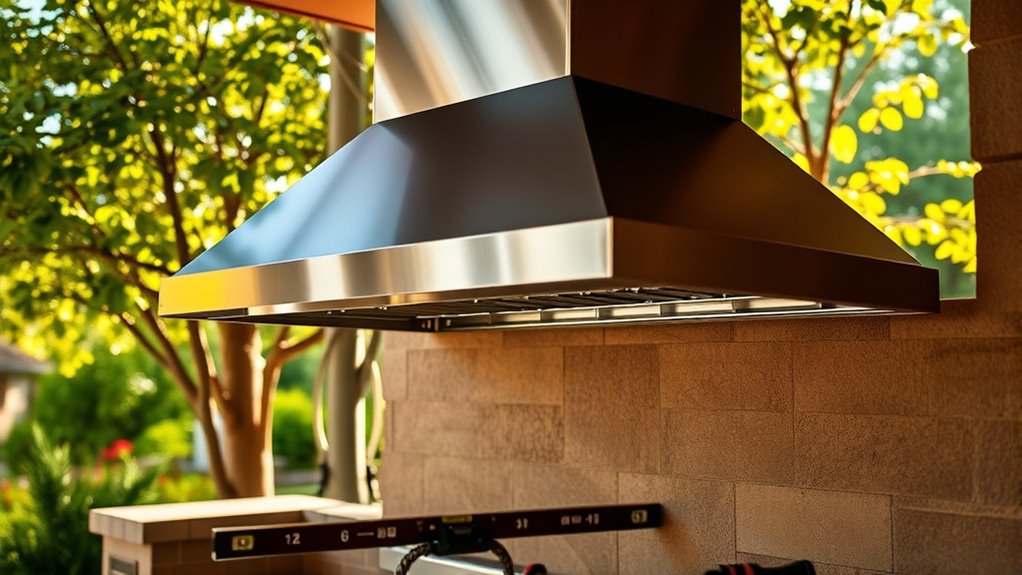
Many homeowners overlook how much professional installation can actually cost, leaving them unprepared for unexpected expenses. When you start your project, don’t forget to contemplate these key factors:
- Accurate cost estimation: Failing to get detailed quotes can lead to surprises. Always ask for a clear breakdown of expenses.
- Contractor selection: Choosing an inexperienced or unlicensed contractor might save money upfront but can cause costly mistakes later.
- Additional fees: Be aware of potential costs like permits, inspection fees, or extra materials that aren’t included in initial estimates.
Failing to Account for Future Upgrades and Repairs

Failing to take into account future upgrades and repairs can lead to unexpected costs down the line. When planning your outdoor vent hood, consider how it might need upgrades to improve performance or adapt to new technologies. Ignoring potential future upgrades can cause you to spend more later, as retrofitting or replacing parts often costs more than planned. Additionally, neglecting repair costs can leave you caught off guard when components wear out or break. To avoid this, choose durable materials and consult with professionals about long-term maintenance. By factoring in future upgrades and repair costs now, you’ll save money and reduce downtime later, ensuring your vent hood remains efficient and functional for years to come.
Frequently Asked Questions
How Can I Ensure My Vent Hood Withstands Harsh Outdoor Weather Conditions?
To guarantee your vent hood withstands harsh outdoor weather, choose one with corrosion resistance and a windproof design. Regularly inspect and clean it to prevent buildup that can weaken materials. Select durable, weatherproof materials like stainless steel. Installing it securely and adding protective covers can also shield it from strong winds and rain. These steps will help your vent hood last longer and maintain peak performance despite tough outdoor conditions.
What Are the Common Local Building Code Requirements for Outdoor Vent Hoods?
You need to check your local permits and safety standards before installing your outdoor vent hood. Local building codes often specify vent hood placement, materials, and ventilation requirements to make certain of safety and efficiency. Visit your city’s building department or website to get detailed guidelines. Complying with these requirements helps you avoid fines, ensures proper airflow, and guarantees your vent hood meets safety standards for outdoor use.
How Do I Choose the Best Ventilation Route for Outdoor Installations?
You might think choosing a ventilation route is simple, but optimizing airflow is key. To select the best outdoor installation route, consider the ventilation pathway’s length and obstructions, which affect efficiency. Opt for a direct, unobstructed path that minimizes bends and turns, enhancing airflow optimization. Guarantee the route adheres to local codes and avoids areas prone to debris or moisture buildup. Proper planning guarantees effective venting and long-term durability.
Which Materials Offer the Best Longevity and Weather Resistance for Vent Hoods?
For the best longevity and weather resistance, you should choose materials with high durability like stainless steel or aluminum, which resist rust and corrosion. Applying weatherproof coatings enhances their resilience against rain, snow, and UV rays. These materials and coatings together guarantee your vent hood withstands outdoor elements, reducing maintenance costs and extending its lifespan. Regularly inspect and clean your vent hood to maintain its integrity over time.
What Routine Maintenance Steps Are Essential for Outdoor Vent Hood Longevity?
Think of your outdoor vent hood as a trusty garden gate that needs regular care. You should routinely replace filters to keep airflow smooth and remove debris that can clog or damage the system. Check for rust or corrosion, clean the exterior, and inspect for leaks. These simple steps guarantee your vent hood stays strong against the elements, saving you money and headaches down the line.
Conclusion
Skipping the details might save you money now, but it could cost you everything later—time, effort, and unexpected expenses. While a cheap vent hood seems tempting, neglecting proper weatherproofing or permits can turn your outdoor kitchen into a costly mistake. Investing in quality, professional installation, and routine maintenance may seem like extra steps, but they protect your peace of mind. Don’t let overlooked details turn a simple upgrade into a costly regret.
